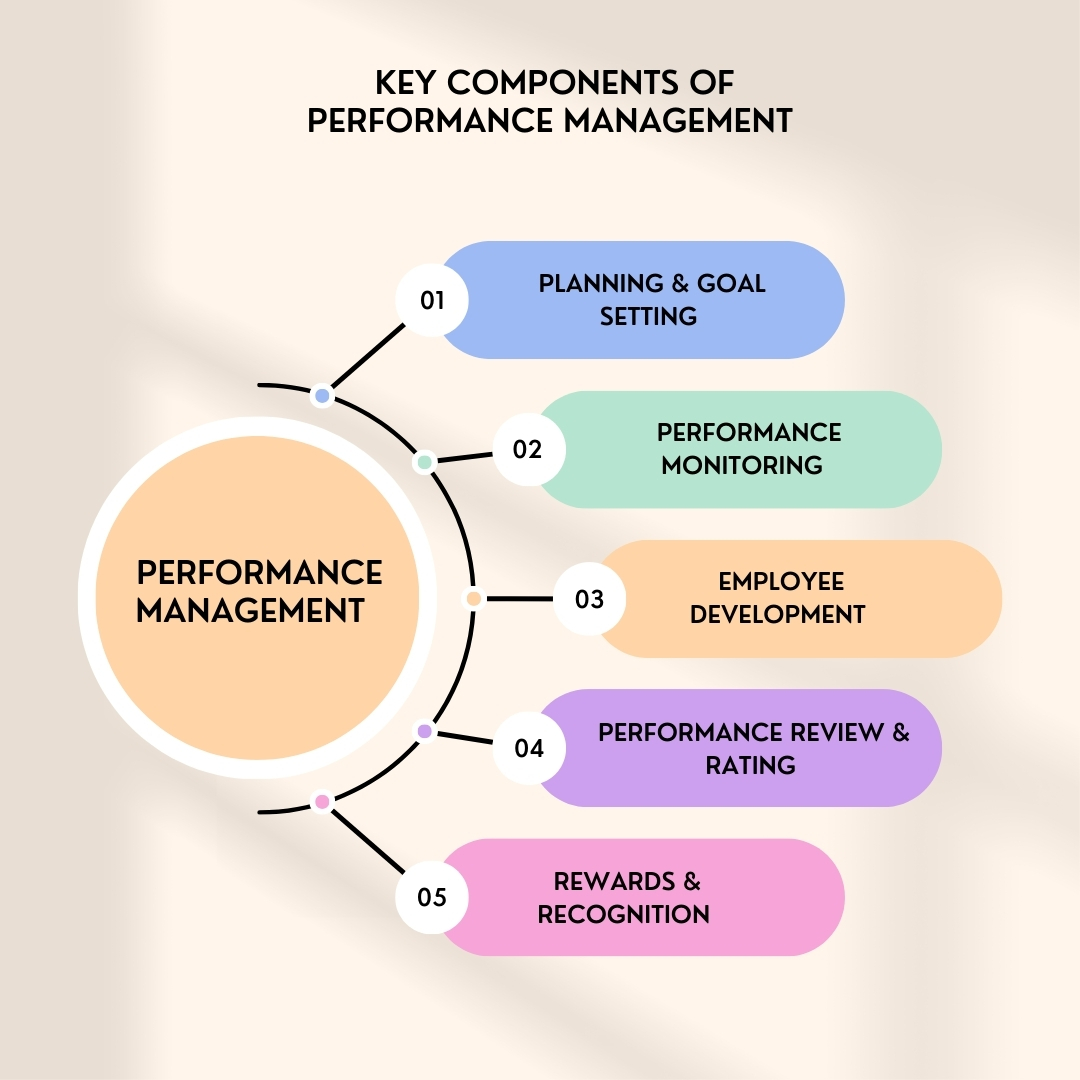What is Performance Management?
Performance management refers to the process of monitoring and evaluating employee performance. It is a continuous process that involves setting performance goals, and expectations, providing feedback, and assessing performance. The primary objective of performance management is to facilitate learning and skill development of employees while ensuring alignment with organizational goals. An effective performance management program will have a continuous system where employees, managers, and HR engage in systematic discussions to evaluate strengths and areas for improvement.
Components of Performance Management
Planning & Goal Setting
Planning and goal setting are foundational steps in performance management. This involves establishing measurable goals in the form of KPIs, defining evaluation methods, and setting clear timelines. You may discuss these goals with the employee and consider their input to confirm the expectations and set priorities.
Performance monitoring
Performance monitoring is a crucial element in performance management as it helps to understand employee progress, productivity, strengths, and areas for improvement. This continual monitoring helps to ensure alignment with business objectives and helps to develop a culture of responsibility, transparency, and continuous improvement.
Employee Development
Employee development is an essential component of performance management. With the data from the monitoring stage, organizations can emphasis on improving the skills, knowledge, and capabilities of employees. Organizations can empower employees by identifying gaps and offering training and mentorship programs. Employee development promotes a culture of learning and engagement, which can have a positive impact on workplace performance.
Performance Review & Rating
Performance review and rating is a component that acknowledges the efforts of employees. Performance reviews and ratings are based on insights from employee monitoring, goal setting, and the established KPIs. This process helps managers identify any necessary resources or training while enabling employees to identify their strengths and areas for improvement. These ratings determine the appraisal and determine the opportunities for salary hikes or promotions.
Rewards & Recognition
Recognition and rewards encourage and motivate employees to do their best. Such rewards send out a clear message that their contributions matter. It also creates friendly competition amongst employees and makes them strive to do better next time. Acknowledging their hard work with rewards affirms their efforts, encouraging higher productivity and efficiency. Moreover, it sets standards for future projects.

Challenges of Performance Management & Solutions
Lack of Clear Goals & Expectations
Setting goals and expectations for each employee helps ensure objectives are aligned with the broader organizational strategy. Using the SMART goals criteria— Specific, Measurable, Achievable, Relevant, and Time-Bound goals help define these objectives effectively. Communicating goals between employees helps to establish a sense of clarity and transparency, allowing individuals to take responsibility for achieving organizational success.
Inconsistent Performance Management Activity
Without an efficient and well-established system for performance management, organizations often struggle to identify challenges and roadblocks faced by the employees. As a result, these issues persist until the next performance evaluation, impacting employee performance and their ability to achieve the set targets. Therefore, having consistent performance reviews and activity and encouraging open dialogue between managers and employees helps in identifying and addressing any relevant issues, creating a positive environment of accountability.
Inadequate Employee Feedback
Inadequate feedback leaves employees unsure about their contributions and performance, and it significantly limits prospects for growth and development. Effective feedback should identify performance gaps and clearly define areas for improvement. Constructive feedback is essential for supporting employee growth and creating a healthy and positive work environment.
Lack of Training & Development
Training and development are critical components of performance management because they equip employees with the necessary skills. Effective training ensures alignment with company objectives and standards, allowing for improved decision-making and problem-solving. It also creates an environment of constant learning, creativity, and experimentation. Organizations that invest in training and development motivate employees to do better, which leads to increased productivity, job satisfaction, and better overall performance management.
Resistance to Feedback
Addressing performance concerns can be difficult when some employees resist feedback. To overcome this, one must use specific communication strategies, patience, and sensitivity to understand the resistance. HR professionals can try to establish a secure place for communication by emphasizing the developmental value of feedback to help employees accept it positively.
FAQs
How often should performance evaluations be conducted?
While the frequency of performance evaluations varies among organizations, they are most commonly conducted on an annual basis. However, some organizations may choose to conduct evaluations twice a year or on a quarterly basis.
How can managers handle underperforming employees?
Underperforming employees must be handled gently. Try to communicate and understand if they are facing any challenges or roadblocks, and offer support, feedback, guidance, and training for improvement. However, despite the extended support, if the employee continues to underperform, disciplinary action can be taken, according to the organizational policy.
What is the main function of performance management?
The major function of performance management is to evaluate employees and ensure that their performance aligns with organizational objectives. This includes establishing clear expectations, tracking progress, offering feedback, and assessing performance. Performance management seeks to increase employee productivity, development, and engagement.
What is the performance management cycle?
The performance management cycle refers to the process which organizations use to manage employee performance and optimize according to organizational goals. It has been divided into four major stages:
- Planning
- Monitoring
- Reviewing
- Rewarding.
Conclusion
Performance management is a fundamental aspect of any business, that helps in maximizing employee potential and enhancing organizational success. Effective performance management involves a structured process for goal setting, recognition, and rewards. By leveraging innovative HRM software solutions like PayWheel, organizations can streamline their performance management process and gain insightful data for informed decision-making.